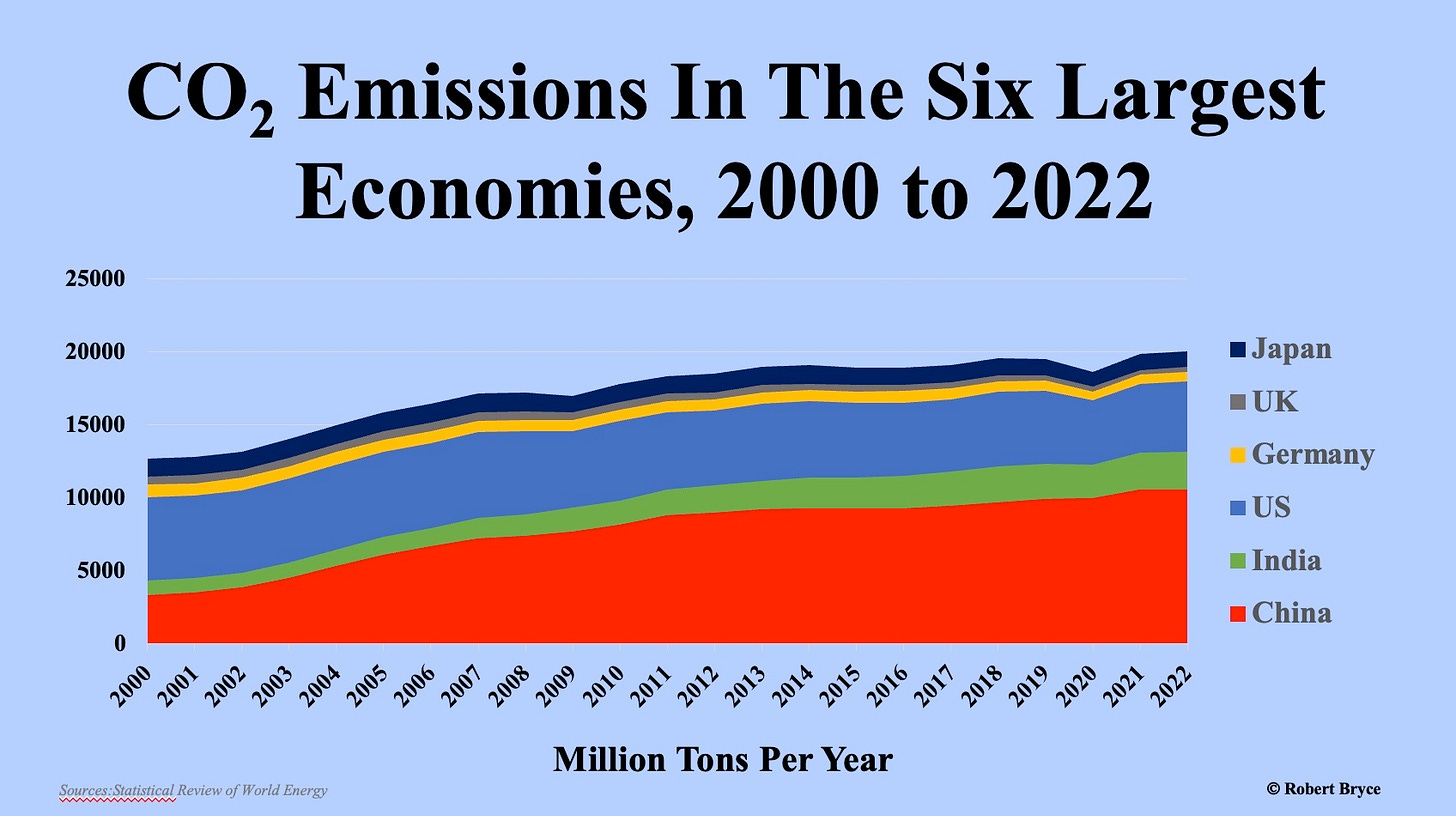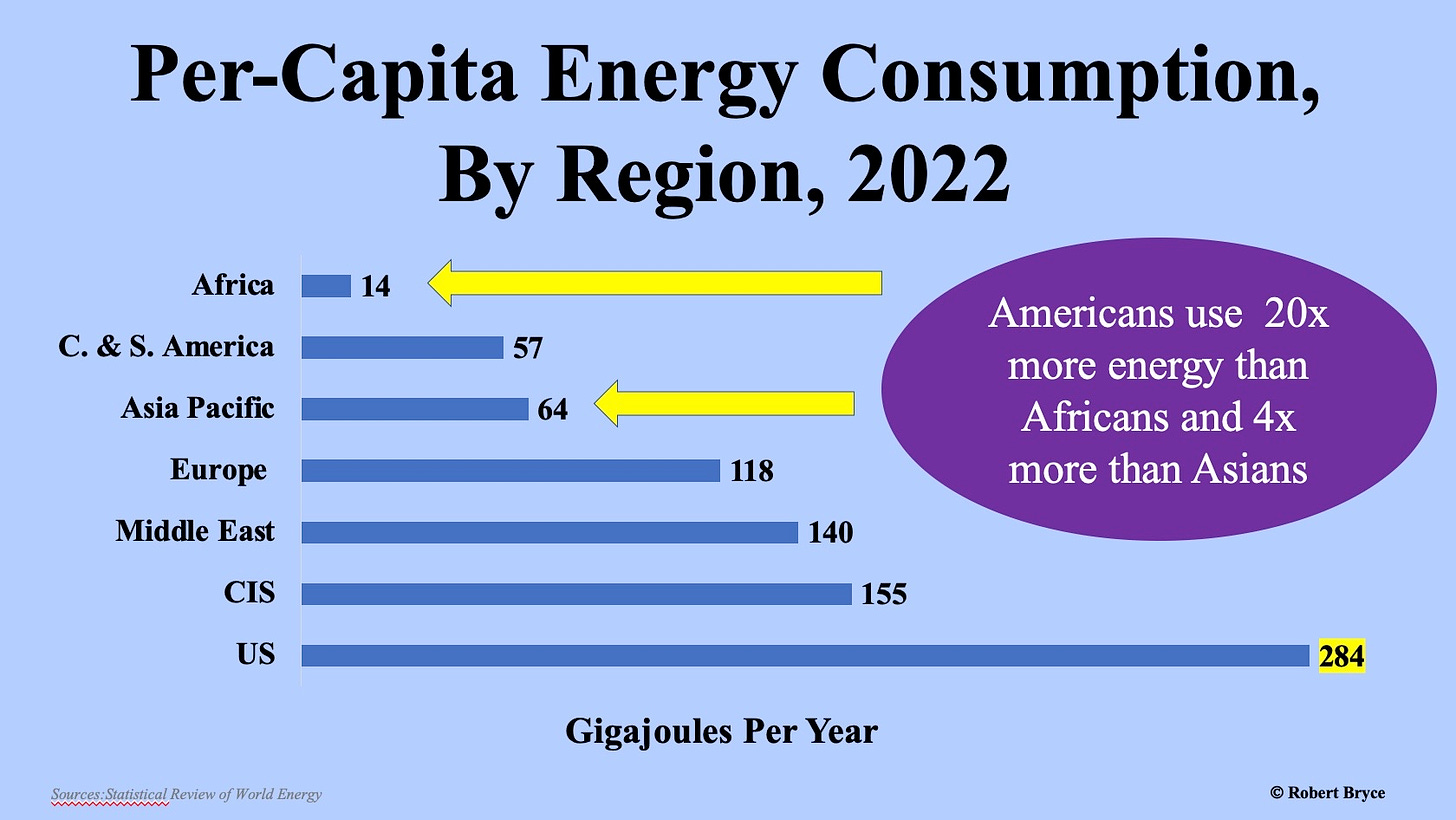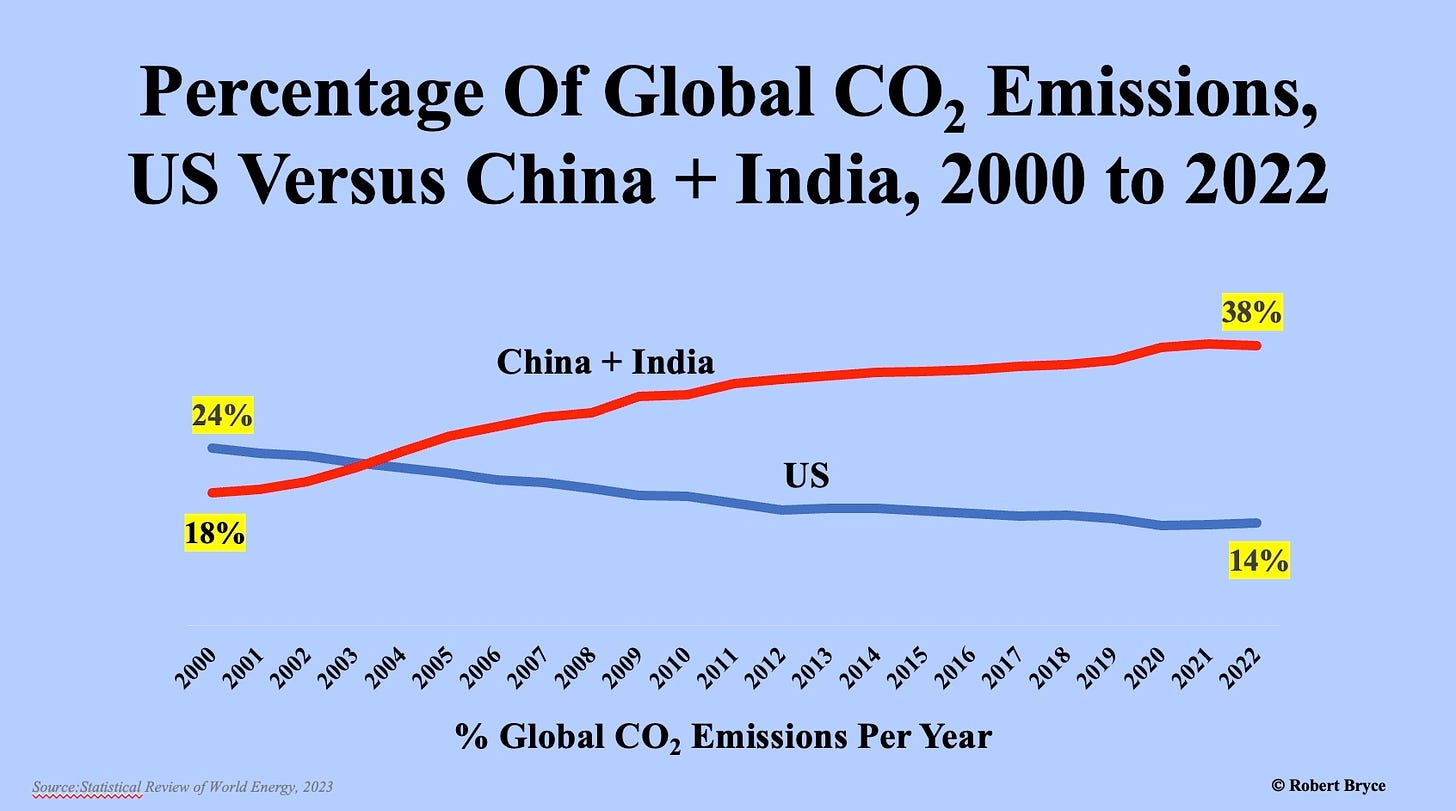Carbon Myopia
On a planet where more than 3 billion people are living in energy poverty, America’s CO2 emissions are fading in importance

Last week, a journalist at Heatmap Daily sent out an email that began, “Nearly a year ago, Senate Majority Leader Chuck Schumer and Senator Joe Manchin of West Virginia made an emergency announcement. It altered the history of climate change.”
While that over-the-top-and-around-the-maypole bit of hype is notable, it’s not an isolated example. Last August, after Vice President Kamala Harris cast the clinching vote in the Senate, thereby assuring passage of the Inflation Reduction Act, (which was also the focus of last week’s Heatmap epistle), New York Times columnist Paul Krugman published a piece headlined “Did Democrats Just Save Civilization?” Krugman gushed about the legislation, writing that “experts on energy and the environment are giddy over what has been accomplished” and the “world is a more hopeful place than it was just a few weeks ago.”
President Joe Biden was similarly smitten. During a signing ceremony at the White House on August 16, 2022, he call the bill the “biggest step forward on climate ever.” Meanwhile, Recharge News declared the Inflation Reduction Act “may prove to be the single most important event in the history of green hydrogen.”
I could cite many more examples like the ones above. But all of those claims reflect an America-centric carbon myopia, a self-absorbed disconnect between what is happening here — where we take energy abundance for granted — and the hard realities of a world in which more than 3 billion people are living in energy poverty.
America’s CO2 emissions are less important with each passing year. As can be seen in the graphic above, which shows the world’s six largest economies, soaring emissions in China and India are overwhelming whatever reductions are occurring in the U.S., Germany, Japan, and the U.K.
Why does this matter? By 2040, the U.S. will have spent a staggering $2 trillion on climate-related projects (More on that number in a moment.) Second, the U.S. share of global emissions is falling as more developing countries industrialize and increase their energy use.
Indeed, while the climate claque clucks about rising EV sales and favorite color-of-the-rainbow hydrogen, billions of people on the planet are stuck in dire energy poverty. The average American now consumes 20 times more energy per year than the average resident of Africa, and four times more than the average resident of Asia. Need another comparison? There are 1.4 billion Africans, who, on average, consume about 600 kilowatt-hours of electricity per capita, per year. The average American consumes that much electricity every three weeks.
Before going further, let me be clear: I am not arguing that the U.S. shouldn’t be trying to cut its emissions. The latest Statistical Review of World Energy confirms that the U.S. has, on an absolute basis, cut its emissions more than any other country on the planet over the past two decades. Since 2000, the U.S. has slashed its emissions by about 915 million tons, that’s greater than the combined reductions of Germany (-219 Mt), the U.K. (-221 Mt), and Japan (-164 Mt).
What I am arguing — and the latest data from the Statistical Review prove it — is that reductions in the U.S. and Western Europe are being swamped by increases in the rest of the world, and in particular, in India and China. Thus, the big challenge facing the world is not how many Teslas are being sold in Marin County, but how many coal plants are going to be built in Bangladesh, Cambodia, and other desperately poor countries.
As I reported in “The Iron Law of Electricity Strikes Again As Vietnam Boosts Coal Burn,” China permitted two new coal plants per week in 2022. In addition to what’s happening in China, nearly 19 gigawatts of new coal-fired capacity was brought online last year, with the biggest new additions happening in India, Japan, and Pakistan.
As can be seen in the graphic above, the U.S. share of global CO2 emissions has been falling drastically. In 2000, the US accounted for 24% of global emissions. Last year, it was 14%. Over that same time frame, the share of global emissions represented by China and India together has more than doubled, going from 18% to 38%.
Furthermore, given the vast disparity in energy use between the wealthy countries and the poor ones, there’s every reason to expect that this trend will continue. As Africa, Asia, and the Middle East get wealthier, they will use more hydrocarbons and their CO2 emissions will inevitably increase. And that trend will continue whether the U.S. likes it or not. Earlier this month, in South Africa, Mineral Resources and Energy Minister Gwede Mantashe, blasted Western climate policies aimed at promoting “green” energy in developing countries. A July 4 article in the country’s Daily Investor reported:
Mantashe has labeled the Just Energy Transition a foreign concept created by developed nations that do not apply to South Africa. Mantashe addressed the Black Business Council last week, where he sharply criticised the pace at which South Africa is transitioning to renewable energy. The minister urged South Africa to exercise energy sovereignty and not be a conduit for ideas from the developed world.
“We cannot work on the basis of a program developed in the Developed North,” said Mantashe, “We are not the same. We pretend to be a developed economy, but we are not. We are a developing economy in a poor continent.”
The country must transition on its own terms and not according to a foreign programme. The minister urged the business leaders in attendance to drive investment into tapping South Africa’s gas and oil reserves. He also pushed them to develop an upstream petroleum industry to capitalise on oil and gas discoveries by South Africa’s neighbours, such as Mozambique and Namibia. “If we were to exploit gas and oil, we will turn the economy around, and we will grow more quickly,” Mantashe said...Instead of focusing on decarbonisation, [he said] South Africa should focus on eradicating energy poverty first.
Africa represents only part of the looming surge in CO2 emissions. Asian countries are also booming. Between 2000 and 2022, global CO2 emissions increased by 10,700 million tons. Of that increase, about 10,300 Mt occurred in the Asia-Pacific region. And while China (7,222 Mt) and India (1,636 Mt) together accounted for 83% of that increase, other countries in the region are also seeing rapid growth. Over the past decade, CO2 emissions in Vietnam have grown at an annual rate of 7.6%, which means those emissions will double in just 10 years. In Indonesia, annual emissions have grown by 3.9% since 2012 and in Bangladesh, they’ve surged by 6.4%. Those three countries are home to more than half a billion humans, all of whom are desperate to use more energy of all kinds.
These numbers get scant attention from legacy media outlets and policymakers because they don’t fit the narrative that the U.S. is saving the planet by building battery plants for EVs. That lack of attention to the big picture of the climate challenge reflects another disconnect. While climate change gets lots of media coverage from legacy media outlets and activists, it’s not a major concern for voters, particularly ones who work for a living. I discussed this issue with Democratic strategist and demographer, Ruy Teixeira, on the Power Hungry Podcast on May 16, 2023. (It’s on YouTube.)
We discussed his recent article, “The working class isn’t down with the green transition.” In that piece, Texiera noted that “In a new Monmouth poll, just one percent of working-class (noncollege) voters in an open-ended question identify climate change as the biggest concern facing their family.” He also cited a recent University of Chicago Energy Policy Institute poll done with AP-NORC. He noted that “in terms of costs Americans would be willing to absorb to fight climate change, the survey finds that just 38 percent of Americans would be willing to pay even $1 extra on their monthly household energy expenses to combat climate change. That’s the lowest figure since AP-NORC started asking this question in 2016. It’s down 14 points since 2021 and an amazing 19 points since its high point in 2018.”
Those findings provide a stark contrast with the spending binge now underway. In March, the Brookings Institution estimated that the climate provisions of the Inflation Reduction Act could cost taxpayers a staggering $1.2 trillion by 2040, that’s more than three times more than the estimates that were published by the federal government last year. Goldman Sachs has also pegged the cost at $1.2 trillion. Now add in the money that’s already been spent. In January, Bloomberg New Energy Finance published its Renewable Energy Investment Tracker, which found that between 2004 and 2022, U.S. spending on weather-dependent renewables totaled some $738 billion. Add that to the Brookings estimate and you find the U.S. will spend some $2 trillion on climate-related stuff by 2040.
In other words, the U.S. is launching a climate-spending binge at the very moment the federal deficit is soaring and now stands at an almost unimaginable $32.5 trillion. This year, interest payments on that staggering amount of borrowed money will exceed $1 trillion. Put another way, the U.S. will spend $2 trillion in an attempt to address a problem it can’t solve, to satisfy the demands of a cadre of lavishly-funded climate activists (and their corporate patrons) who don’t represent the views of the overwhelming majority of Americans.
So what is the best no-regrets path forward? The answer, as I have been saying for more than a dozen years, is N2N: natural gas to nuclear. Those sources are mature, low- or no-carbon, affordable, can be deployed at scale, and perhaps most important, have very high power density. N2N is where the U.S. can lead and make a real difference in global emissions and poverty eradication.
As I noted in “The EPA’s China Syndrome,” China holds a near-monopoly on the metals, minerals, and magnets needed for alt-energy technologies, including solar panels, wind turbines, and EVs. Rather than play in China’s sandbox, the U.S. should commit to rapid development and exploitation of Africa’s vast natural gas resources to help fuel that continent’s electrification efforts. It can do so by instructing entities like the Export-Import Bank to make loans for gas development projects and by pressuring the World Bank to do the same. The U.S. should also accelerate the development and approval of a new fleet of smaller, safer, cheaper, nuclear reactors that can be exported to energy-poor countries around the world.
This will, of course, require sensible action from Congress. Instead of fire-hosing hundreds of millions of dollars on weather-dependent renewables, EVs, hydrogen, and similar corporate giveaways that are in the Inflation Reduction Act, Congress should focus on nuclear energy. The trillion-dollar legislative love child birthed by Schumer and Manchin includes tax credits for nuclear power worth about $30 billion. The tax credits for wind and solar (the production tax credit and investment tax credit) will cost taxpayers at least $131 billion. Those figures should be reversed. After that, Congress should accelerate and streamline the permitting process for domestic mining and processing of uranium, and reform the Nuclear Regulatory Commission so that it can expedite the permitting and construction of next-generation reactors that can be deployed and installed both here in the U.S. and around the world.
Those would be bold moves. If enacted, they really could alter the history of climate change.
Before you go:
Please click the ♡ button.
I sincerely appreciate your support. If you haven’t done so, please subscribe to this Substack and share it.






Left-wing authoritarianism, something long denied by (mostly) left-leaning academia plus narcissism and Cluster B dynamics as the default “operating system” explains the behavior of these goons.
Thank you Robert. I am one of the fortunate people who has had the experience of traveling to many Developing countries of the world and witnessed seeing a family of four driving on a motorcycle, with one of the people holding a 25 pound propane tank, two holding on and one driving. In Pakistan I remember seeing mother's cooking over cow dung. Energy poverty such as this leaves a very deep impression in one's mind. Your points are well taken and spot on. Keep up your excellent work.
One more thing. To support your post on the lifting from poverty of the people in Developing countries, Liberty Energy has an excellent report, "Bettering Human Lives" https://www.libertyenergy.com/wp-content/uploads/2022/08/Bettering-Human-Lives-Liberty-Energy-ESG-Report-2021-Spreads-Web-2.pdf